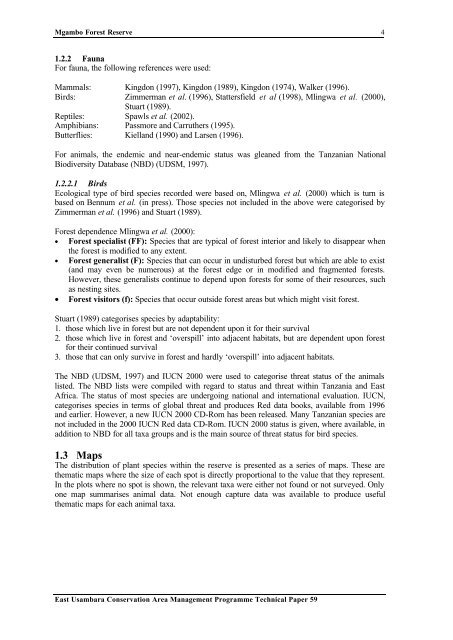Mgambo Forest Reserve: A biodiversity survey. - Eastern Arc ...
Mgambo Forest Reserve: A biodiversity survey. - Eastern Arc ...
Mgambo Forest Reserve: A biodiversity survey. - Eastern Arc ...
Create successful ePaper yourself
Turn your PDF publications into a flip-book with our unique Google optimized e-Paper software.
<strong>Mgambo</strong> <strong>Forest</strong> <strong>Reserve</strong><br />
4<br />
1.2.2 Fauna<br />
For fauna, the following references were used:<br />
Mammals: Kingdon (1997), Kingdon (1989), Kingdon (1974), Walker (1996).<br />
Birds: Zimmerman et al. (1996), Stattersfield et al (1998), Mlingwa et al. (2000),<br />
Stuart (1989).<br />
Reptiles: Spawls et al. (2002).<br />
Amphibians: Passmore and Carruthers (1995).<br />
Butterflies: Kielland (1990) and Larsen (1996).<br />
For animals, the endemic and near-endemic status was gleaned from the Tanzanian National<br />
Biodiversity Database (NBD) (UDSM, 1997).<br />
1.2.2.1 Birds<br />
Ecological type of bird species recorded were based on, Mlingwa et al. (2000) which is turn is<br />
based on Bennum et al. (in press). Those species not included in the above were categorised by<br />
Zimmerman et al. (1996) and Stuart (1989).<br />
<strong>Forest</strong> dependence Mlingwa et al. (2000):<br />
• <strong>Forest</strong> specialist (FF): Species that are typical of forest interior and likely to disappear when<br />
the forest is modified to any extent.<br />
• <strong>Forest</strong> generalist (F): Species that can occur in undisturbed forest but which are able to exist<br />
(and may even be numerous) at the forest edge or in modified and fragmented forests.<br />
However, these generalists continue to depend upon forests for some of their resources, such<br />
as nesting sites.<br />
• <strong>Forest</strong> visitors (f): Species that occur outside forest areas but which might visit forest.<br />
Stuart (1989) categorises species by adaptability:<br />
1. those which live in forest but are not dependent upon it for their survival<br />
2. those which live in forest and ‘overspill’ into adjacent habitats, but are dependent upon forest<br />
for their continued survival<br />
3. those that can only survive in forest and hardly ‘overspill’ into adjacent habitats.<br />
The NBD (UDSM, 1997) and IUCN 2000 were used to categorise threat status of the animals<br />
listed. The NBD lists were compiled with regard to status and threat within Tanzania and East<br />
Africa. The status of most species are undergoing national and international evaluation. IUCN,<br />
categorises species in terms of global threat and produces Red data books, available from 1996<br />
and earlier. However, a new IUCN 2000 CD-Rom has been released. Many Tanzanian species are<br />
not included in the 2000 IUCN Red data CD-Rom. IUCN 2000 status is given, where available, in<br />
addition to NBD for all taxa groups and is the main source of threat status for bird species.<br />
1.3 Maps<br />
The distribution of plant species within the reserve is presented as a series of maps. These are<br />
thematic maps where the size of each spot is directly proportional to the value that they represent.<br />
In the plots where no spot is shown, the relevant taxa were either not found or not <strong>survey</strong>ed. Only<br />
one map summarises animal data. Not enough capture data was available to produce useful<br />
thematic maps for each animal taxa.<br />
East Usambara Conservation Area Management Programme Technical Paper 59
















